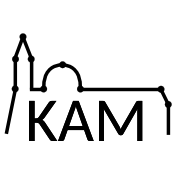Workshop on Structures celebrating Ales Pultr birthday
October 4 - October 5, 2018, Prague
Announcement
The workshop will take place in Mala Strana in the refectory (1st floor) and will consist of invited lectures on Thursday and Friday October 4-5. We hope you will come. Below you find the program with the abstracts of the lectures.
Program
Thursday October 4th
- 10:00 Jarik Nesetril
- 11:00 Rick Ball
- 14:00 Jan Krajicek
- 15:00 Dan Kral
- 16:00 Vasek Chvatal
Friday October 5th
- 10:00 Igor Kriz
- 11:00 Martin Loebl
- 14:00 Jorge Picado
- 15:00 Jan Kratochvil
Jaroslav Nesetril: Algebraic Representation
Representing posets, groups, monoids and categories by other structures is associated with Prague school of categories. In this lecture we survey recent development which puts this classical topic in a yet another (combinatorial and model theoretic) context.Rick Ball: TBA
Jan Krajicek: Pseudofinite and Euler structures
Pseudofinite structures (infinite structures satisfying the first-order theory of all finites structures) can be seen as limits of sequences of finite structures of increasing sizes, and their properties represent asymptotic properties of the sequence. Various problems in computational and proof complexity can be formulated as tasks to construct expansions of such structures with particular properties, in many cases having to do with counting of sizes of definable sets. I will presents some basic notions and illustrate this topic by few theorems and open problems.Dan Kral: Step Sidorenko property and weakly norming graphs
There has recently been a lot of interplay between extremal graph theory and the theory of graph limits. After a brief survey of the theory of dense graph limits, we focus on exploring a link between Sidorenko's Conjecture, one of the most prominent open problems in extremal graph theory, and weakly norming graphs, one of the concepts studied in the theory of graph limits. Sidorenko's Conjecture asserts that every bipartite graph H has the Sidorenko property, i.e., a quasirandom graph minimizes the density of H among all graphs with the same edge density. We are interested in a stronger property, which we call the step Sidorenko property. We relate this property to weakly norming graphs and use our results to construct a bipartite edge-transitive graph that is not weakly norming - this answers a question of Hatami [Israel J. Math. 175 (2010), 125-150]. The talk is based on joint work with Taisa Martins, Peter Pal Pach and Marcin Wrochna.Vasek Chvatal: Points and lines
A set of n points in the Euclidean plane determines at least n distinct lines unless these n points are collinear. In 2006, Chen and Chvatal asked whether the same statement holds true in general metric spaces, where the line determined by points x and y is defined as the set consisting of x, y, and all points z such that one of the three points x,y,z lies between the other two. We will trace the curriculum vitae of the conjecture that it does hold true and point out related open problems.Igor Kriz: Rings and modules in sheaves of Kan spectra
I will discuss my current joint work in progress with Ales Pultr and Ruian Chen on foundations for a theory of constructible sheaves of generalized cohomology theories. I will explain the potential applications of such a theory, and its basic technical challenges. A key step in realizing the program is constructing a suitable notion of a "tensor product" in an appropriate context, which I will outline. On a deeper philosophical level, I shall reflect on the many cases I encountered throughout my career where "tensor products" play key roles in various fields of mathematics, starting with my 1980's thesis work in Prague under Ales Pultr's supervision.Martin Loebl: The odd case of Rota's bases conjecture
Rota's bases conjecture: For any system A = (A1, . . . , An) of non-singular real valued (n x n) matrices the multiset of all columns of matrices in A can be decomposed into n independent systems of representatives of A. I will discuss our results with Ron Aharoni towards proving the conjecture for n odd (the case n even has been better understood). I will also present broader connections of this conjecture in the theory of matchings of graphs and hypergraphs.Jorge Picado: Hausdorff mapping invariance theorem for locales
The well-known result that normality is invariant under closed continuous maps was first observed by Hausdorff in 1935. We will illustrate the 'art of pointfree thinking' by showing how the covariant description of localic maps and sublocales in [J. Picado and A. Pultr, Frames and Locales: topology without points, Springer, Basel, 2012] yields a straightforward proof of the pointfree counterpart of Hausdorff mapping invariance result. With the introduction of a relative notion of normality, defined in terms of a selection S of complemented sublocales, our approach gains two additional features: (1) it covers several variants of normality; (2) just by taking complements in S, it yields dual results about extremal disconnectedness type properties. Other cases treated are e.g. the perfect and hereditary properties.Jan Kratochvil: TBA
Webmaster: kamweb@kam.mff.cuni.cz Modified: 26. 09. 2018
